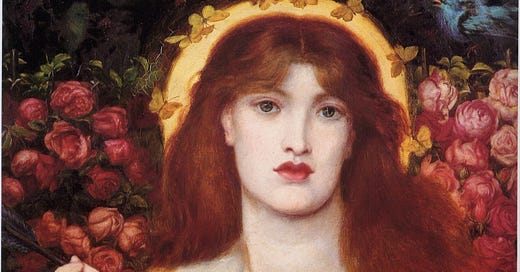I recently attended an fascinating presentation about Roman attitudes towards women in the Republican period. Of particular interest to me was one female figure I hadn’t heard of before, and the intriguing events she was involved in. This woman was Sulpicia; not the author of the same name, or even the Twilight character, but the daughter of Servius (or Gaius) Sulpicius Paterculus. She features in the story of Venus Verticordia and, perhaps, the world’s first beauty pageant - bear with me, I will explain. But the story goes deeper still, and we find ourselves down an all too familiar rabbit hole of women being used to oppress others. However, before all that, let’s explore the story first…
Who Was Sulpicia?
This particular Sulpicia was born to the patrician family known as the gens Sulpicia. Roman naming conventions are all fun and games until you realise that every woman born in that family is called Sulpicia, so it sometimes takes a while to find the right one. This Sulpicia was likely the daughter of a consul, elevating her position in society even further, and married Quintus Fulvius Flaccus. Flaccus was consul four times and was busy during the events of the Second Punic War. Needless to say, Sulpicia was a highly regarded woman in Roman society.
Venus Verticordia
At some point in the late 3rd Century BC, the Romans consulted their trusty Sibylline Books, which contained many interesting prophecies to interpret, and decided that a new Goddess needed to be introduced. Now let’s not get ahead of ourselves, this wasn’t a new new goddess, but in fact a new form of the goddess Venus. Greek and Roman gods could typically have many forms or faces which emphasised the different parts of their character - think Athena Nike or Athena Parthenos, where she is emphasised as Victory and Virgin alternately. At this time, Rome decided they needed to dedicate a statue to Venus Verticordia - literally the ‘turner of hearts’.
This facet of Venus, the goddess of love and beauty, emphasised her role in turning Roman women from libido (sexual desire) to pudicitia (sexual virtue). This may ring a bell if you’re at all familiar with those abstinence movements that tend to spring up in particularly religious parts of the world. Romans were no strangers to conservative values, so it seemed important to focus their goddess of love on the proper way to celebrate this, by properly married women with their proper husbands.
Rome’s First Beauty Pageant?
When the time came to dedicate the statue, it was decided that this would require a feminine touch. Women were not regularly involved in religious activity, in fact it was mostly frowned upon, but this special occasion called for a special woman. The men of Rome therefore devised a way of identifying the most virtuous woman in all of Rome, who would mirror the pudicitia of Venus Verticordia.
Valerius Maximus records that a list of 100 Roman matronae - respectable, married women - was drawn up and from them, 10 were chosen by lot. These ten then chose the most virtuous among them to be their representative and, hey presto! Sulpicia became Rome’s most virtuous lady. Unfortunately there were no competitions, no parades or rose ceremonies, just a straightforward selection process. Maybe they missed a trick?
Sulpicia would become a quasi-mythic figure after this, because once you raise someone up to be such a bastion of purity, the embellishments and hyperbole flow naturally. Valerius describes her as sanctissima, most holy, and praised for her pudicitia and castitas (chastity). I’m sure she was overall a very respectable person, and perhaps luckily she didn’t get the dramatic backstory of a Lavinia or a Lucretia. Some suggest that the statue was modelled after her, but we may never know.
What’s Missing?
This all sounds well and good, perhaps even admirable - look at them raising up women, those little feminists! However there is some very important context missing here which sours the whole story I’m afraid. You see, the time period in which all this happened is extremely relevant - the end of the Second Punic War. Many of you may have heard of a certain Hannibal and his exploits, the upshot of which was that perhaps over 100,000 Roman men were killed fighting on Italian soil, though ultimately Rome was victorious. The flow on effects of this were immense for Roman society.
A city or a state does not simply lose a massive swathe of one gender and not feel the repercussions. As an immediate result, many Roman women became widows and thus inherited their husband’s estate, especially if their sons had died as well. This led to a sudden surge in wealthy women in Rome, no longer under the control of their father or husband. They could go where they liked, how they liked and even sleep with whomever they liked. This was, unsurprisingly, a nightmare for Roman conservatives; and they were swift to act.
How Do We Solve A Problem Like Matronae?
A range of methods were employed to address this issue, including taxation and confiscation of male-less estates, laws prohibiting lavish public displays of wealth by women, and restrictions on their participation in religious rites. Most serious of all, however, was the crack-down on affairs between unmarried partners, or even widows with married men. Some widowed matronae were even put on trial as a public reminder of patriarchal power over women.
And so it is within this context that the story of Sulpicia and Venus Verticordia took place. The Roman state was hellbent on curbing the power and the promiscuity of women, and so of course they came up with a way to turn the people’s attention to the very opposite idea. Venus literally was turning their hearts, and minds, away from the libido that stalked the populace, to their lovely conservative values of castitas and pudicitia.
What’s New?
When I heard this whole story, I couldn’t help but think of the modern obsession over masculine and feminine gender roles among right wing influencers, and in particular the ‘tradwife’ ideal that has become so prominent. These seek to ‘restore the balance’ of a ‘traditional’ society and empower women by… returning them to their role as housewives? So many of these types of ‘influencers’ focus on the very same values the Romans did during Sulpicia’s time, and similarly try to couch it in a positive sense, when ultimately it is designed to suppress and control women.
It’s no surprise that this far-right focus on women as wives and mothers has another historical rhyme in the German regime of the 1930s. The Nazis were masters of propaganda and used this messaging to control women and make them willing participants in their fascist state. Interestingly, the extreme focus on motherhood and childbearing had similar parallels in the Augustan period, when Rome simply needed to repopulate its upper class after decades of Civil Wars. It’s perhaps not surprising that, throughout history, in times of crisis and the troubles that follow, the roles and rights of women are the first to be suppressed and distorted.
Thanks for reading as always. Please let me know if you have any thoughts!






